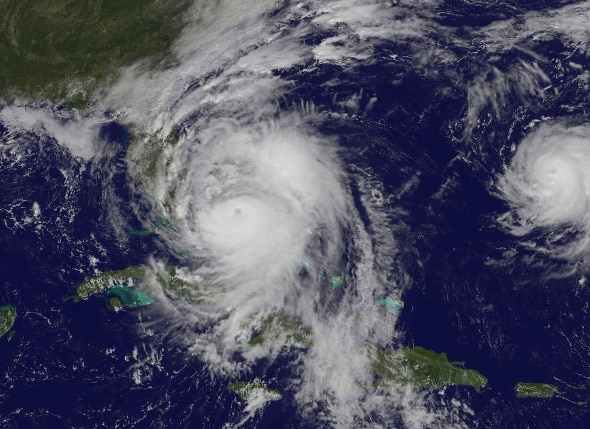Create a free profile to get unlimited access to exclusive videos, sweepstakes, and more!
As Hurricane Matthew Hits Florida, What Will It Do to NASA?

Update, Oct. 9, 2016: As hoped, it looks like KSC got through Matthew with only relatively little damage. Eric Berger at Ars Technica has more details.
Update and correction, midnight: I've now heard the GOES-R satellite, mentioned below, was not mated to the rocket (note: that was my error, not of the sources below), and also that is in Titusville, across the Indian River and so technically not at the Cape, but instead a few kilometers away. We'll learn more once the all clear is given at KSC and people are allowed back.
Update, noon: I've heard from two sources that the GOES-R satellite is sitting inside an Atlas rocket at the Cape. It was protected by a hurricane enclosure, but I'm awaiting word it made it through OK. Ironically, it's a weather satellite.
Update at 11:30 a.m.: NASA is reporting that the hurricane center has passed north of Kennedy Space Center, and there is some damage but it's minimal. Phew! Here's the quote:
Hurricane Matthew has now passed offshore from Cape Canaveral and is north of Kennedy Space Center. The wind is starting to decline but remains near tropical storm strength. However, until the wind is consistently below 50 knots a crew cannot be sent outside to begin a more thorough look at KSC. That is expected sometime this afternoon. At this time there is observed to be limited roof damage to KSC facilities, water and electrical utilities services have been disrupted and there is scattered debris. Storm surge has been observed to be relatively minimal, limited to localized portions of the space center. The Damage Assessment and Recovery Team will be brought in for its formal assessment Saturday morning.
Original post, 9 a.m.: Hurricane Matthew is a monster. It went from a run of the mill tropical depression to a full blown hurricane in less than a day, strengthening explosively as it drew energy from deep, warm waters. It passed over Haiti, doing vast damage and killing more than 300 people, and now its sights are set on the east coast of Florida and points north.
I will not downplay this storm. With top wind speeds of more than 220 kph (140 mph) the damage it can do is not to be underestimated. Its path along the coast is guaranteed to do a lot of hurt.
Beside the obvious worries, I’ve seen a lot of questions and speculation on social media about what the hurricane might do to NASA’s Kennedy Space Center and launch facilities; while they aren’t on the direct path of the hurricane eye, it’ll pass close. As Eric Berger points out at Ars Technica, most of the buildings there are built to withstand hurricane winds of more than 160 kph, and some more. But Matthew has winds exceeding this, so it may very well damage the center.
The facility has been evacuated, with only a very thin skeleton crew on hand to ride it out. Mind you, several launch pads could be damaged as well. The working SpaceX pad was already damaged when a Falcon 9 rocket exploded while fueling in September. It’s unclear what the hurricane could add to it. I’ll note it’s safe to assume that all rockets and other equipment at the center have been secured.
As hard as it is, we’ll just have to wait and see what this thing does. Having lived through a few hurricanes, I’ll say it can be terrifying. I hope everyone reading this in that area stays safe and that our nation’s space assets are safe as well.
As an aside, I’ll note that this hurricane seems to have the fingerprints of global warming all over it. As climatologist Michael Mann notes the deeper layer of warm water fueling it is a product of extra warming going into the ocean, and there has been a trend of the most powerful recent storms getting stronger. I worry that as powerful as this hurricane is, we will probably see more like it in the coming years.
For more information, I recommend keeping an eye on Weather Underground, which is an excellent source of information. And again, folks: Be safe.
N.B. Before anyone accuses me of politicizing a tragedy, let me note that science is not in itself a political thing, but it certainly can be a pawn to it. Also note that it already has been politicized by the usual right-wing deniers like Matt Drudge and Rush Limbaugh, who, even for them, have stooped unusually low, including possibly putting lives at risk. My main concern now is with the immediate threat and the safety of people, property, and ecosystems; there will be time later to go into more depth about the causes of this storm.


























